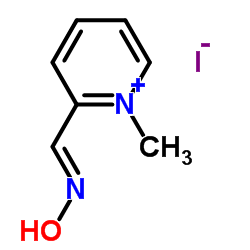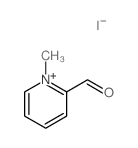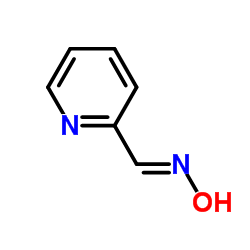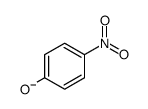94-63-3
| Name | pralidoxime iodide |
|---|---|
| Synonyms |
2-Pyridinealdoxime methiodide
2-hydroxyiminomethyl-1-methylpyridinium iodide protopamiodide EINECS 202-349-6 1-methyl-2-hydroxyiminomethylpyridinium iodide Pyridinium, 2-[(E)-(hydroxyimino)methyl]-1-methyl-, iodide (1:1) pralidoximemethiodide PRALIDOXIMELODIDE PYRIDINE-2-CARBOXALDOXIME METHIODIDE PRALIDOXIME IODIDE MFCD00011982 pyridin-2-aldoxin p-2-am 2-PAM 2-pamiodide 2-[(E)-(Hydroxyimino)methyl]-1-methylpyridinium iodide 2-[(hydroxyimino)methyl]-1-methylpyridinium iodide |
| Description | Pralidoxime iodide is a reactivator of acetylcholinesterase (AChE). Pralidoxime iodide reactivates nerve agent, which inhibits AChE via direct nucleophilic attack by the oxime moiety on the phosphorus center of the bound nerve agent. Pralidoxime iodide is an antidote for organophosphate poisoning[1][2]. |
|---|---|
| Related Catalog | |
| In Vivo | Pralidoxime iodide (10-150 mg/kg; i.m.) reverses paraoxon-induced respiratory toxicity in mice[3]. Animal Model: Male F1B6D2 mice (toxic but non-lethal model of diethylparaoxon in awake, unrestrained mice)[3] Dosage: 10, 50, 100 and 150 mg/kg Administration: Intramuscularly Result: Reversal of diethylparaoxon-induced respiratory toxicity at 150 mg/kg. |
| References |
[2]. Eyer P, Buckley N. Pralidoxime for organophosphate poisoning. Lancet. 2006;368(9553):2110‐2111. |
| Density | 1.7439 g/ml |
|---|---|
| Melting Point | 220 °C (dec.)(lit.) |
| Molecular Formula | C7H9IN2O |
| Molecular Weight | 264.064 |
| Exact Mass | 263.975952 |
| PSA | 36.47000 |
| Storage condition | 2-8°C |
CHEMICAL IDENTIFICATION
HEALTH HAZARD DATAACUTE TOXICITY DATA
|
| Symbol |

GHS07 |
|---|---|
| Signal Word | Warning |
| Hazard Statements | H302 |
| Personal Protective Equipment | dust mask type N95 (US);Eyeshields;Gloves |
| Hazard Codes | Xn:Harmful; |
| Risk Phrases | R22 |
| Safety Phrases | S36 |
| RIDADR | NONH for all modes of transport |
| WGK Germany | 3 |
| RTECS | UU4375000 |
|
~% 
94-63-3 |
| Literature: Bioorganic and Medicinal Chemistry, , vol. 21, # 18 p. 5923 - 5930 |
|
~79% 
94-63-3 |
| Literature: Hampl, Frantisek; Mazac, Jiri; Liska, Frantisek; Spogl, Jiri; Kabrt, Lubomir; Suchanek, Miloslav Collection of Czechoslovak Chemical Communications, 1995 , vol. 60, # 5 p. 883 - 893 |
|
~% 
94-63-3 |
| Literature: Journal of the American Chemical Society, , vol. 79, p. 481,483 |
| Precursor 4 | |
|---|---|
| DownStream 1 | |




